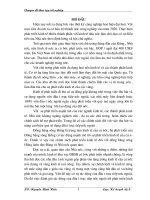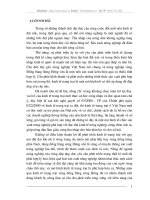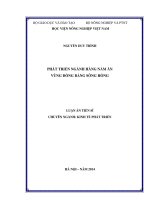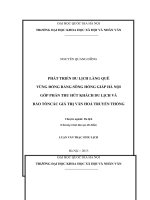Phát triển công nghiệp làng nghề vùng đồng bằng Sông Hồng (2)
Bạn đang xem bản rút gọn của tài liệu. Xem và tải ngay bản đầy đủ của tài liệu tại đây (220.47 KB, 27 trang )
VIETNAM ACADEMY OF SOCIAL SCIENCES
GRADUATE ACADEMY OF SOCIAL SCIENCES
DO VIET HUNG
INDUSTRIAL DEVELOPMENT OF TRADE VILLAGE AT
THE RED RIVER DELTA
Mayor: Development Economics
Major code: 62.31.01.05
SUMMARY OF ECONOMIC PHD DISSERTATION
HA NOI, 2017
The dissertation completed at:
VIETNAM ACADEMY OF SOCIAL SCIENCES
GRADUATE ACADEMY OF SOCIAL SCIENCES
Academic of Supervisor: 1. Dr. Tran Minh Yen
2. Assoc. Prof. Dr. Nguyen Xuan Dung
Reviewer 1: Prof.Dr. Nguyen Quang Thai
Reviewer 2: Assoc. Prof. Dr. Bui Quang Tuan
Reviewer 3: Dr. Nguyen Ba An
The dissertation will be defended at University level
council of dissertation Assessment at Graduate Academy of
Social Sciences, No. 477, Nguyen Trai Stresst, Thanh Xuan
District, Ha Noi.
The dissertation could be found at:
- Vietnamese National Library
- Library of Graduate Academy of Social Sciences
LIST OF RELATED RESEARCH PROJECTS
PULISHED BY AUTHOR
1. Do Viet Hung (2016), “Sustainable development craft villages Ha
Noi in the intergration period”, Review of Regional Sustainable
development, Volume 6, No. 4, December 2016, Page. 52-58.
2. Do Viet Hung (2016), “Development of the Red River Delta craft
villages”, Economic Studies, No. 10 (461), October 2016, Page 70-80.
3. Do Viet Hung (2016), “Developing craft villages in Red River Delta:
Real situation and solutions”, Socio - Economic infomation and
forecast Review, No. 125, May 2016, Page 16-21.
4. Do Viet Hung (2016), “Experience developed a craft of some
Asian countries and lessons for the development of villages Red
River Delta”, Asia - Pacific Economic Review, any II, April 2016,
Page 46-48.
5. Do Thi Thanh Loan, Do Viet Hung (2016), “The combination of
sustainable development of traditional craft villages and tourism in
Ha Noi, expriences for the central provinces of Viet Nam”,
International Conference “Sustainable tourism development of
south central coast of Viet Nam”, Puplisher Hong Duc, Ha Noi,
Page. 577-587.
INTRODUCTION
1. Significance of the research
Development of diversed industrial of rural economy plays an
important role in social-economic development strategy in our country.
In which, development of trade village is one of important agenda in
agricultural and rural industrialization and modernization process.
Industrial development of trade village, one of problem of rural
industry, plays an essential part in social-economic development
process in rural area. Indeed, it has a variety of positive and effective
impacts on social division of labor, economic restructuring, goods and
services production; and significantly encourages the development of
handicraft industry, traditional industry and other. In addition,
industrial development of trade village also creates jobs, increases
salary, improves life, contributes to poverty alleviation, and conducts
an extroverted economic model and “leaving agriculture without
leaving home” target in rural area.
The Red River Delta, including 11 cities and provinces, is highly
representative of scale, number of trade village, diversification of
occupations and handicraft products, and typical production method. It
also has convergence of great potential and development opportunities
for a thousand of highly skilled workers and artists, and produces
various handicraft products for consumption and exports.
In contrast, there are still some backdraws in the development of
trade village at the Red River Delta, namely spotanepous, small and
scattered production without plans or commensurating with the potential;
products with low quality and less creative designs; low-tech and
outdated equipment, limited ability of international competition of
handicraft products, inappropriate resource allocation and usage,
increased environmental pollution; limited role and advantages in local
1
economic, cultural, social development, non-comparative advantage in
sustainable development, and incompatible with the requirements of
economic restructuring and movement and development of the economy.
Trade village development in an industrial manner is a suitable
direction with the aim of changing production efficiency, taking
advantage of production capacity of handicraft villages, satisfying the
connection in development, providing for the industrial supply chain,
and meeting the need of market. Besides that, in order to maximize
the potential and advantage in development of trade village, changing
the efficiency in production, and promoting local socio-economic
development in the period of innovation and integration, the author
has chosen the topic “Industrial development of trade village at the
Red River Delta" as his doctoral thesis.
2. The aim and research task of the dissertation
2.1. The aim the dissertation
In terms of eonomic development perspective, the thesis has
researched the theoretical issues, which leads to a situation assessment of
industrial development of trade village and suggested some major solution
for industrial development of trade village at the Red River Delta.
2.2. The research task of the dissertation
- To clarify the theoretical basis of industrial development of
trade village
- To practical research in some countries or some national areas, and
- To analyze and assess the situation of industrial development of
trade village at the Red River Delta, evaluating the achievements and
limitations, and indicate cause of these limitations.
- To analyse the context, then suggesting an opinion-oriented
solution for industrial development of trade village at the Red River
Delta until 2020 and vision 2030.
2
3. Subjects and scope of the research
3.1. Subjects of the research: Industrial development of trade village
at the Red River Delta.
3.2. Scope of the research:
- To concentrate on researching situation
development of trade village at the Red River Delta.
of industrial
- To research trade villages at the Red River Delta, consisting of 11
cities and provinces. To do a practical survey at Hanoi, Bac Ninh, anh
Thai Binh, especially two villages in each area.
4. Methodology and Research methods of the dissertation
4.1. Methodology
The thesis is based on the methodology of dialectical materrialism
and historical materialism, and the inheritance of the methodology of
modern economic research of economic development.
4.2. Research methods
4.2.1. Approaches: Institutional approach; System approach; Costeffectiveness analysis approach; Career approach; Sustainable approach.
4.2.2. Main research methods
- Secondary data collection; Sociological Investigation; Synthesis,
statistics, comparison; Data analysis.
5. Contributions of Dissertation
The result of thesis research states some point of views in
academic and arguments, include:
- To systematize basic argument problems about developing
industrial development of trade village: give notion of industrial
development of trade village, building the criterion systems to evaluate
industrial development of trade village.
3
- To provide relative completed and detailed real situation of
industrial development of trade village at the Red River Delta
- To evaluate studiously about achievement and limitation for
industrial development of trade village at the Red River Delta in
during time; especially, explained some causes of achievement and
limitation from different respects and levels.
- To evaluate and clear for background, advantage and
disadvantage impacting to industrial development of trade village.
- To propose opinion system, specific solution for industrial
development of trade village at the Red River Delta, including
solutions is applicable for drawing up policy and highly realizable.
6. Theoretical significance and practical significance of the
dissertation
In terms of theory: The thesis contributes to clarify some basic
theoretical argument of of industrial development of trade village in
economic perspective.
In terms of practice: The thesis also can be used as a reference for
various research activities and teaching. These recommendations can
help the management agencies ranging from the government to the
local authority develop its trade villages.
7. Chapter Layout of Dissertation
Besides the introduction, conclusion, and references, the
dissertation is organized in four chapters as follows:
Chapter 1. Research overview
Chapter 2. Methodology and background of industrial development
of trade village.
Chapter 3. The status of industrial development of trade village at
the Red River Delta.
4
Chapter 4. The solution for industrial development of trade village at
the Red River Delta.
Chapter 1
RESEARCH OVERVIEW
1.1. Literature review
1.1.1. Foreign researches
Pierre Gourou - France (2003); Dang Nguyen Anh, Cecilia,
Hoang Xuan Thanh (2004); Richard Bolt (2004). Yared Awgichew Ethiopia (2010); N.Suzuki - Japan, 2006; K.Routra - Thailand 2007;
Bargeret Pascal (2005).
1.1.2. Domestic researches
1.1.2.1. Rural industrial development, agricultural and rural
industrialization and modernization researches.
Nguyen Dien (1997); Dang Ngoc Dinh (1997); Dang Le Nghi
(1998); Vu Thi Thoa (2000); Chu Huu Quy và Nguyen Ke Tuan (2001);
Nguyen Dinh Phan, Tran Minh Dao, Nguyen Van Phuc (2002); Nguyen
Xuan Thao (2004); Do Duc Quan (2008); Dang Kim Son (2008).
1.1.2.2. Handicraft villlage, traditional village and handicraft village
development studies.
Mai The Hon, Hoang Ngoc Hoa, Vu Van Phuc (2002); Tran
Minh Yen (2004); Ho Hoang Hoa (2004); Vu Thi Thoa (2009); Le
Van Huong (2010); Dinh Xuan Nghiem (2010); Hoang Ha (2011);
Bui Van Tien (2012); Vu Ngoc Hoang (2016).
1.1.2.3. Development of trade village at the Red River Delta researches.
Nguyen Tan Trinh (2002); Nguyen Tri Dinh (2005); Nguyen Vinh
Thanh (2006); Tran Đoan Kim (2010); Lê Thi Kim Hoa (2010); Nguyen
Huu Thang (2010); Trịnh Kim Lien (2013); Le Xuan Tam (2014).
5
These studies has focused on analyzing local natural, economic
and social characteristics as the impact factor, evaluating the situation
and factors related to trade village development, which leads to
suggestions for future research of industrial development of trade
village at the Red River Delta
1.2. Overall assessment of research situation
1.2.1. The assessment of overview of research situation
1.2.2. The researched problems can be inherited in the thesis
1.2.3. Further studies of the dissertation
To clarify the theoretical basis of industrial trade village. To
deeply assess situation of industrial development of trade village, to
clarify the results, existence and some questions in industrial
development of trade village at the Red River Delta. To analysis and
assess all trends and to propose solutions for industrial development of
trade village in a comprehensive manner.
Therefore, this dissertation is an independent thesis and does not
coincide with the names and content of other published scientific
works. This research is considered as a reference for further studies of
the dissertation with the purpose of dealing with all unaddressed
issues - downtime of researching industrial development of trade
village at the Red River Delta.
Chapter 2
METHODOLOGY AND BACHKGROUND OF INDUSTRIAL
DEVELOPMENT OF TRADE VILLAGE
2.1. Theoretical bases of developing trade village industry
2.1.1. Trade village
2.1.1.1. Definition of trade village
6
Trade village is a socio - economic institution, or alternatively, a
cluster or multiple clusters of people living in a community (village)
where an occupation or multiple occupations, which are not
agricultural, are existing and constituted to be an independent
production and business organization in a common geographical space.
Number of households, number of workers and income gained from
these occupations account a major proportion of the total product value
of the entire village.
2.1.1.2. Features of trade village
Regarding to technological level; to the scale of production; to
conditions of production and business; to production and business
organization; to sources of raw materials.
2.1.2. Rural industry
2.1.2.1. Definition of rural industry
Rural industry is a monophyletic definition referred to as a part of
the industry, which is conducted in rural areas, or to activities of
production having industrial properties, which take place in rural areas
and as a result of the process of the division of labor in place.
2.1.2.2. Characteristics of rural industry
Rural industry is considered as a part of the industry with different
levels of development, distributed in rural areas, linked to socioeconomic development in rural areas.
2.1.3. Trade village industry
2.1.3.1. Definition of trade village industry
Trade village industry is a monophyletic definition referred to as
a part of the industry, which is conducted in trade villages, or to
activities of production having industrial properties, which take place
in trade villages and as a result of the process of the division of labor
in place.
7
Trade village industry is production activities of the trade villages,
in which the use of machinery, equipment, applications of advanced
techniques and modern technology is essential, it is adapted with style
of industrial organization to combine closely,
rationally and
harmoniously the uses of resources, to create high labor productivity,
to have large market, to offer the products that meet the needs of
production and consumption for domestic and export markets.
2.1.3.2. Characteristics of trade village industry
Regarding to scale; to technical and technological levels; to
specialization and to products.
2.1.4. Development of trade village industry
Development of trade village industry is determined as the
process of developing the production activites with industrial
properties in the trade villages, in order to improve the production
quantity, quality and organizing structure of trade villages by using
machinery, equipment, applications of advanced techniques and
modern technology, being adapted with style of industrial
organization to combine closely, rationally and harmoniously the
uses of resources, to create high labor productivity, to have large
market, to offer the products that meet the needs of production and
consumption for domestic and export markets.
2.1.5. The role of the development of trade village industry
2.1.5.1. Increasing the value of production, exports
2.1.5.2. Using rationally productive resources
2.1.5.3. Economic restructuring in rural areas and diversifying the
rural economy sectors towards industrialization and modernization
2.1.5.4. Promoting comparative advantage
2.1.5.5. Solving social problems
2.1.5.6. Bringing into full play and promoting the national cultural values
8
2.1.6. Contents of development of trade village industry
2.1.6.1. Development of organizational forms of production
In the trade villages, various forms of production and business
organizations are availabe such as: Household, cooperatives, private
enterprises, limited liability companies, joint stock companies. These
forms coexist and support each other in a market economy. The
connections between the trade village with other business
organizations are set up such as connection in term of input and output
services , connection between the production phases.
2.1.6.2. Development and application of science and technique, technology
Advanced technology being adequate to the resources, capability,
management skills will be a strong force for the rapid and sustainable
development. For development of trade village industry the application
of science and technology is an important content for improving the
quality, style, design and lowering the cost of products as well as
improving product competitiveness.
2.1.6.3. Expanding scale of labor resources
The labor force of the village consists of the artisans, craftsmen,
owners of business and production units in trade villages. Artisans
have especially important role in the transmission of skill and
vocational training. Abundant labor forces, youth employment
structure having ability to adapt to the new conditions of the market
economy are the crucial factor in deciding the production and business
activities in the development of trade villages.
2.1.6.4. Regarding to material resources
Raw material is one of the important resources in the development
of trade villages. In particular, factors such as the volume and types of
materials, location, supply of raw materials directly affect the quality,
cost and profitability of products of trade villages.
9
2.1.6.5. Products of trade village industry
Products under mass production with industrial machineries and
equipment will have capacity of meeting the customers’ demands,
satisfying their expectation as well as the potential of being offered on
domestic and international markets, bringing the economic profits to
production and business units in trade villages.
2.1.6.6. Development of consumption market
Because of the diversity and regional features of the products, the
evaluation of the market and consumption systems need following the
criteria: Building up and developing product brand name; Promoting,
designing products to meet market demand; Consumptions of products
in the domestic market, foreign market; Through marketing channels:
directly or indirectly.
2.1.6.7. Regarding the development of clusters and association of
trade village industry
Industrial clusters are the area where the enterprises, the
production units in the village are located in united surface. The units
in a cluster associate with each other in terms of jointly building and
using technical support works, the infrastructures in order to improve
capital efficiency, to reduce the cost of developing management, to
ensure economic, social and environmental targets.
2.1.7. Some criteria for evaluating development of trade village industry
2.1.7.1. The proportion of application of machineries, technologies
intrade villages
2.1.7.2. Developing trade village industry associated with agriculture,
trade and services
2.1.7.3. Promoting traditional character in development of trade
village industry
10
2.1.7.4. Special and quintessential character of products of trade
village industry
2.1.7.5. Development of trade village industry in the way of goods
production
2.1.7.6. Associated factors in trade village industry
2.1.8. Factors affecting development of trade village industry
2.1.8.1. Natural conditions
2.1.8.2. Socio - economic conditions
2.1.8.3. Regime and policy of development of trade villages
2.1.8.4. Market
2.1.8.5. International economic integration.
2.2. Theories concerning with development of trade village industry
2.2.1. The theory of value chain
2.2.2. The theory of cluster
2.2.3. Model of two regions by Harry T.Oshima
2.2.4. The theory of sustainable development
Researching the economic theories in question is the basis for
applying the tools needed in research and development of trade
village industry.
2.3. Practical basis of development of trade village industry
2.3.1. Experience in developing trade village industry of some asian
countries
2.3.1.1. Experience of Japan
2.3.1.2. Experience of China
2.3.1.3. Kinh nghiệm in Thailand
2.3.2. Experience of some regions in Vietnam
2.3.2.1. Experience in developing trade village industry in Mekong Delta
2.3.2.2. Experience in developing trade village industry in South
Central Coast
11
2.3.3. Appliable lessons to development of trade village industry in
Red River Delta
2.3.3.1. Lessons from international experiences
Position and role of conservation and development of trade
villages in the strategy of economic development; Policies and
supports of the Goverment and local Authorities; Incorporation
between industry and small handicraft industry; Expanding market and
boosting the consumption of products; Focusing on training labor
force for trade villages; Development of trade village associated with
solving enviromental issues.
2.3.3.2. Lessons from experience of some regions in Vietnam
- The active supports of the Government and local authorites are
significant to boost and develope trade village industry
- Organizing production of handicrafts, trade village products
towards industrialization and diversification of commodities, focusing
on create uinque products with distinctive characteristics.
- Focusing on applying, enhancing modern technology to improve
productivity, product quality and limit environmental pollution.
Combining traditional technologies with modern technologies.
- Developing trade village by building industrial parks, clusters
fitting the specific characteristics of each local.
- Promoting the connection between local, production units,
between the trade villages.
Chapter 3
THE STATUS OF INDUSTRIAL DEVELOPMENT OF TRADE
VILLAGE AT THE RED RIVER DELTA
3.1. Overview of trade villages in Red River Delta
3.1.1. Natural, socio-economic characteristics of Red River Delta
3.1.1.1. Natural characteristics
3.1.1.2. Socio-economic characteristics
12
3.1.2. Polices regarding to development of trade village industry in
Red River Delta
Guidelines and policies have the remarkable impact on the
development of trade villages. Therefore, the intervention of the State
in the activities of production and business development under
conditions of developing market economy is a necessity.
3.1.2.1. Policies of planning
3.1.2.2. Polices regarding land issues
3.1.2.3. Polices of science and technology
3.1.2.4. Polices of trainning human resource
3.1.2.5. Polices of investment, credit, tax and pricing
3.1.2.6. Policies of trade promotion, product consumption
System of abovementioned policies have a major impact on,
create a favorable environment, support to activities of production
and business. The policy innovation has helped to organizations,
households and establishments in the trade villages be facilitated for
long-term stability and expansion of production and business
development.
3.1.3. Overview the current status of developing trade villages in Red
River Delta
3.1.3.1. Number and structure of trade villages in Red River Delta
Up to 2014, there are 2447 trade villages in Red River Delta
particularly (accounting 48% of total 5.096 in all over nation), in
which 875 trade villages has been already recognized.
3.1.3.2. Production value of trade village, economic restructuring
The production value of trade villages has steadily increased over
the years. The development of trade villages has contributed
significantly in restructuring the local economy.
13
3.1.3.3. Mobility trends of trade villages in Red River Delta
Oblivion trend of some villages; Developing strongly the villages
well meeting the needs of the market; Developing the traditional
occupations to meet the needs of modern society; Developing the trade
village associated with tourism.
3.1.3.4. Current status of some environmental problems in trade villages
The survey showed that farmers in trade village area and
surrounding areas are affected and much damaged by the
environmental pollutions in trade villages.
3.2. Situation of development of trade village industry in Red
River Delta
3.2.1. Some major features of trade village industry in Red River Delta
Firstly, trade village industry in Red River Delta has been
developed on the basis of the production units in the village.
Secondly, the scale of trade village industry is often larger than
the scale of production of conventional villages.
Thirdly, the application of advanced techniques and modern
technology is considered as the driving force of development.
Fourthly, trade village industry is developing towards modern
trends through the form of chain link.
Fifthly, trade village industry has vast consumption market,
which is relatively stable.
Sixthly, trade village industry does not break the structure of trade
village, and still combine the traditional elements with modern elements.
3.2.2. Situation of development of trade village industry in Red
River Delta
3.2.2.1. Regarding to form of production organization
14
The development process of trade village regions in general and
trade village industry in particular has created a huge change in the
organization of production and business with two major trends:
- The transformation of production and business from households
into enterprises.
- The development of production and business associations in the
region of trade villages. It is possible to realize that these associations
are often concentrated in the following areas: Association in term of
seeking consumption markets; association among production stages of
a product; associaton in term of capital; association in term of
manpower training.
3.2.2.2. Technique, technology
- Technical and technological features of production process
- Application of technique and technology
The results of investigation and survey show that: The households
are using backward techniques and technologies of production with
almost outdated machineries.
3.2.2.3. Labor force
- Scale and structure of labor force in trade villages
Labor force in trade villages has small scale with gradually
decreasing quantity. The occupation restructure of labor is faster than
the one of household. The scale of trade village is increasingly larger.
The number of households participating in industrial – small handicraft
industrial production is increasing, respectively, the number of
agricultural household is decreasing.
- Quality of labor resource
Quality and technical qualification of labor are improving, but still
lower than required for production. The proportion of unqualified
labor is large, whereas, the number of artisans and high skill workers is
15
small. These are the fundamental issues challenging the development
of trade village industry.
3.2.2.4. Regarding to material resources.
- Current situation of material resource: The trade villages is
usually linked with an available supply of material in the local area.
- The exploiting, supplying and using material is not planned, that
lead to risk of material resource exhaustion.
3.2.2.5. Products of trade village industry
- Structure, quality, and design of products: In Red River Delta,
there are about 200 categories of products. For trade village industry,
development of products is a significant stage, and mainly conducted
by following methods: diversifying the product kinds; continously
creating and renewing the product designs; building up and developing
the unique products.
According to the research results, the basic disadvantages and
difficulities of products of trade village industry are: designing
products upon intention of export; management issues, controlling
product quality as requirement of exporting orders.
3.2.2.6. Consumption market
- Domestic market: it is showing a great potential, the fast
increasing purchasing power. the trade village industrial products is
being served for consumers's demand in the region and partly exported
to other provinces. Most production units have said that their products
are sold in big provinces and cities, and then exported, and finally
served for self consumption in the village.
- For export market: It is offering the potential and great
advantages for development of village industry trade. However, the
direct exported products are facing many difficulties due to issues of
16
product quality, design, brand, that make profits be reduced and affect
the income of the labor in the trade villages.
3.2.2.7. Trade village industrial clusters
The clusters are developed corresponding to the requirement of
development to meet the demand of expanding production scale and
level. The localities in Red River Delta has set up many concentrated
trade village industrial clusters separately with residence areas,
achieved the goals of production growth, expanding activities of
services and trading, solving environmental problems. However, the
industrial clusters are still spontaneous and remain many limitations.
3.3. Overall reviewing development of trade village industry in
Red River Delta
3.3.1. Achievements
- Increasing the value of production, the economic restructuring
in local area
The trade villages has made great contributions to the local budget, to
the total value of production and to the growth of the whole region.
The production value of the trade villages in Red River Delta is
increasing more and more, contributing to economic restructuring,
labor structure locally.
- Development of forms of production organization in the trade
villages
The forms of production organization in the trade villages are
increasingly developing and has a fundamental change of substance,
are highly specialized, become a major driving force in the
development of trade village industry.
- Applicating technical technology and modernizing the trade
villages
17
Many villages have invested in new equipments, technology and
applied scientific and technological advances in production, that has
contributed to increase productivity, improve product quality, and
promote the role of trade villages for rural areas, initially minimize
environmental pollution.
- Diversifying products, expanding consumption market for
products of trade village industry
These products are converging more and more factors with high
cultural content, which have been applied to all handicraft villages and
the modern trade village. Therefore, export products of the village are
increasing rapidly.
- Developing and training of human resources
The skills of labor in the village are being improved, and enable
adapting to new techniques and technologies. The training has been
implemented in various forms, with diversity of contents and
contributed to the stability of production.
- Promoting the development of trade village industrial clusters
and associations
Multiple industrial clusters have been planning, building
infrastructure to attract investment projects; enterprises, production
units, industrial - small handicraft industrial service suppliers handicraft, which have come to invest, carry out their production and
business activities, has contributed to reducing environmental
pollution in craft villages, has contributed to reduce environmental
pollutions in the trade villages.
3.3.2. Existing issues, disadvantages and causes
3.3.2.1. Existing issues, disadvantages
- Regarding to forms of production organization
18
These issues and disadvantages in term of such as: investment and
public services; production level; capital; manpower; capacity of
management and production techniques. The number of enterprises of
trade villages has increased but with small scale in terms of capital
and labor; business management capacity. The sustainablility has been
not paid the respective attention in planning development of
enterprises.
- Regarding to technique and technology
Application of science, technique and technology to production
activities of trade villages is decentralized; backward, that leads to
low-quality products, uneven, not high aesthetic level, weak
competitiveness. Factors of safety, environmental protection,
efficiency, ability of using technology are at low level.
- Regarding to labor force
Labor in trade villages is unable to meet the requirements of
modern production, mechanization. It takes a long time for training,
even after being trained, the labor is still not meet the immediate
requirements of the production. Lack of young labor, skilled labor,
who can meet even the requirements of industrial production in
association with mechanization, technology.
- Regarding to material resources for development of trade village
industry
The expoitation and use of material are implemented massively,
with lack of planning and risk of exhaustion. The trade villages are still
not in connection with the material suppliers, but mainly provided by
the traders. Therefore, the production units have to buy raw materials
through the brokers with unstable sources and price.
- Products of trade village industry
19
Products of trade village industry exist many weaknesses. The system
of design, style, packing has not been renewed, gained, less creatively
improved. Products have simple visuals and big dimension.
- Consumption market
Consumption market is unstable, precarious, through many
intermediate stages. The competitiveness of export products is weak,
the price is squeezed in the market; there is a lack of overall strategy
for village products. It is being proved the inability to establish a
sustainable relationship with the market and the limited ability to
exploit the market.
- Clusters of trade village industry
There are issues of investment, building, decentralized planning
for permissions; management works; the level of using technology;
situation of using land for improper purposes, transfering land
illegally, project delays, waste of land resources; environmental
pollution problems from the parks and village industry.
- Social, environmental existing issues and disavantages
The trade villages are under pressure from increasing labor
issues, jobs, unemployment. Environment of trade villages are the
causes of disease for residents of villages, affect economic activity and
lead to conflict in the community.
3.3.2.2. Causes
- The most common causes:
Awareness of the role of trade village industry; of development
strategy and planning;of development policies and solutions; of
infrastructure development; of supporting the investment capital for
production.
- The causes from existing issues and disadvantages:
20
Regarding to forms of production organization; to the
technological level of trade villages; to labor force; to supplies of raw
materials for production; to product issues, consumption markets; to
industrial clusters.
- Some other causes:
Trade villages are under pressure from labor issues, jobs and
unemployment; lack of skilled labor and adjacent generations.
Environmental problems occur village seriously affecting the lives and
the socio - economic conditions of the local and whole region.
Chapter 4
THE SOLUTION FOR INDUSTRIAL DEVELOPMENT OF
TRADE VILLAGE AT THE RED RIVER DELTA
4.1. The background, opinion, and goal of industrial development
of trade village at the Red River Delta
4.1.1. The content of industrial development of trade village at the
Red River Delta
4.1.1.1. International background
4.1.1.2. National background
4.1.1.3. Evaluation of strengths, weaknesses, opportunities, and challenges
4.1.2. The viewpoint and aim of industrial development of trade
village at the Red River Delta
4.1.2.1. The viewpoint of industrial development of trade village at the
Red River Delta
- To have a new and proper understanding about
development of trade village in market economy.
industrial
- Industrial development of trade village must be placed in the
overall strategy of industrialization and modernization of the country,
region and each local area.
21
- Industrial development of trade village is based on enhancing
economic-social efficiency and ensuring sustainable development.
- It is important to proactively apply advanced scientific and
technical progress to production activities in handicraft village in
order to improve labor productivity.
- Industrial development of trade village need to be associated with
market mechanism and the process of international economic integration.
- Industrial development of trade village can help environmental
and ecological balance, maintaining the quality of life in residential
areas and ensuring social security.
4.1.2.2. The aim
- The overall objective of economic-social development in Vietnam
- The specific objectives of the development of handicraft village
4.2. The solution for industrial development of trade village at the
Red River Delta
4.2.1. General solutions
4.2.1.1. Policy solutions
- Trade policy
- Financial policy, credit policy, tax policy
- Science and Technology policy
- Human resource training policy
4.2.1.2. Solution for infrastructure planning and developing
- Planning
- Infrastructure
4.2.1.3. Capital solutions
- To increase raising capital for industrial development of trade
village
- To improve efficiency in investment
22









